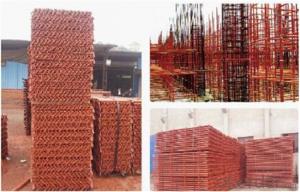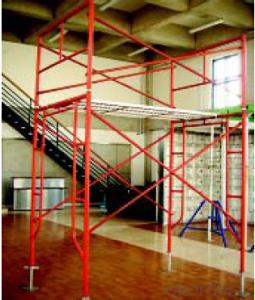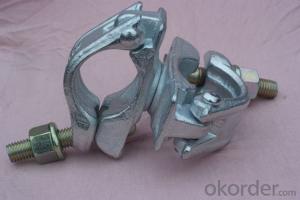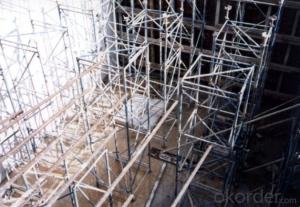Construction Scaffold Ladder Clamp
- Loading Port:
- China Main Port
- Payment Terms:
- TT OR LC
- Min Order Qty:
- -
- Supply Capability:
- -
OKorder Service Pledge
OKorder Financial Service
You Might Also Like
Quick Details
| Place of Origin: | Model Number: | ||||
| Type: | Surface: | Material: | |||
| Color: | Size: | Weight: | |||
| Function: | Brand: | Certification: | |||
| Life span: |
Packaging & Delivery
| Packaging Detail: | Scaffold Ladder Clamp is in bare package, suitable for shipmen. One container can load about 26 tons Scaffolding Beam Clamp . |
| Delivery Detail: | after deposit 10 days |
Specifications
Scaffold Ladder Clamp
1.Galvanized clamp
2.Drop forged ladder clamp
3.Size : 48.3*45mm
4.Hot sale in African market.
Construction Scaffold Ladder Clamp
Details of Construction Scaffold Ladder Clamp
1. Scaffold ladder clamp is made of Q235 steel which has high stength and superior ductility.
2. The production technique is drop forged which assure scaffold ladder clamp presicion specification and strong structure.
3. Galvanized surface clamp has excellent anti-rust property & a longer working life.
4. Diverse type and size of scaffold ladder clamp are provided.
Specification of the Construction Scaffold Ladder Clamp :
| Item | Product | Specification | Weight(kg) |
| clamp | Casting Fix clamp | 48.3*48.3mm | 0.85 |
| Casting Swivel clamp | 48.3*48.3mm | 0.9 | |
| Casting Sleeve clamp | 48.3*48.3mm | 0.9 | |
| Drop Forged Double clamp | 48.3*48.3mm | 1 | |
| Drop Forged Swivel clamp | 48.3*48.3mm | 1.1 | |
| JIS Press Fix clamp | 48.3*48.3mm | 0.58 | |
| JIS Press Swivel clamp | 48.3*48.3mm | 0.58 | |
| BS Press Fix clamp | 48.3*48.3mm | 0.85 | |
| BS Press Swivel clamp | 48.3*48.3mm | 1.05 | |
| Inner Joint clamp | 48.3*48.3mm | 0.77 | |
| Putlog clamp | 48.3*48.3mm | 0.62 | |
| Board Retaining clamp | 48.3mm*40mm | 0.62 | |
| Beam clamp | 48.3*45mm | 1.52 | |
| Press Sleeve clamp | 48.3*48.3mm | 1 | |
| Limpet clamp | 48.3*45mm | 0.3 | |
| German Double clamp | 48.3*48.3mm | 1.2 | |
| German Swivel clamp | 48.3*48.3mm | 1.4 |
- Q: What is a steel tube coupler in scaffolding?
- A steel tube coupler in scaffolding is a device that is used to connect two steel tubes together in order to create a stable and secure scaffolding structure. It is typically made of high-quality steel and is designed to withstand heavy loads and provide a reliable connection between the tubes. The coupler is usually in the shape of a clamp or a sleeve, with bolts or pins that can be tightened to ensure a tight and secure fit. It is an essential component in scaffolding construction as it allows for the assembly and disassembly of scaffolding structures in a safe and efficient manner.
- Q: How do steel tube couplers affect the overall stability of a scaffolding structure during movement or transportation?
- Steel tube couplers play a crucial role in maintaining the overall stability of a scaffolding structure during movement or transportation. These couplers securely connect the individual steel tubes, ensuring that the structure remains rigid and robust. By effectively distributing the load and providing structural support, the couplers minimize any potential movement or deformation of the scaffolding, thus enhancing its stability and safety during transportation.
- Q: What safety measures should be taken when working with steel tube couplers in scaffolding?
- To ensure the safety of workers and prevent accidents when working with steel tube couplers in scaffolding, it is crucial to implement several safety measures. Consider the following key precautions: 1. Training and Competency: Workers must undergo comprehensive training and demonstrate their competence in working with steel tube couplers. This includes understanding their correct usage, installation techniques, and potential hazards associated with scaffolding. 2. Inspection and Maintenance: Regularly inspecting steel tube couplers is essential to identify any signs of wear, damage, or corrosion. Any damaged or faulty couplers should be promptly replaced to maintain the overall structural integrity of the scaffolding. 3. Load Capacity: It is vital to comprehend the load capacity of both the steel tube couplers and the scaffolding system in use. Overloading can result in collapse or failure, leading to severe injuries or fatalities. Always adhere to the manufacturer's guidelines and consult a structural engineer if necessary. 4. Secure Connections: Properly securing the connections of steel tube couplers is crucial for maintaining stability. Ensure that the couplers are tightly fastened and that there is no movement or looseness in the connections. Loose or improperly secured couplers can cause accidents or make the scaffold unstable. 5. Fall Protection: Workers should be equipped with appropriate fall protection equipment, such as harnesses and lanyards, when working at heights. Additionally, install guardrails and toe boards on scaffolding platforms to prevent falls and ensure a safe working environment. 6. Stability and Base Support: Erect scaffolding on a stable and level surface. Properly position and secure the base plates or adjustable jacks to prevent any movement or instability during use. 7. Communication and Signage: Clear communication among workers is crucial to avoid accidents. Use proper signage, such as warning signs and barricades, to mark areas where scaffolding is in use and to inform others to keep a safe distance. 8. Weather Conditions: Take into account the impact of weather conditions on scaffolding stability. Strong winds, rain, or snow can significantly affect the safety and stability of the scaffolding. Regularly check weather forecasts and take appropriate measures to protect against adverse conditions. 9. Personal Protective Equipment (PPE): Workers must be provided with and wear suitable PPE, such as hard hats, safety glasses, gloves, and appropriate footwear, to protect against potential hazards associated with steel tube couplers. By adhering to these safety measures, workers can minimize the risk of accidents, ensure the structural integrity of scaffolding, and create a safe working environment when using steel tube couplers.
- Q: Are steel tube couplers adjustable or fixed in position once installed?
- Once steel tube couplers are installed, they are typically fixed in place. These couplers are specifically engineered to establish a secure and enduring linkage between two steel tubes or pipes. Their predominant application lies in construction, infrastructure, and manufacturing projects that necessitate a robust and lasting connection. Once the coupler is affixed, it is not designed to be modifiable or effortlessly detachable. The connection formed by the coupler is intended to be indissoluble and impervious to any movement or displacement. Consequently, it is crucial to meticulously strategize and situate the couplers prior to installation to guarantee the desired alignment and configuration of the steel tubes.
- Q: Can steel tube couplers be used for angled or curved connections in scaffolding?
- Yes, steel tube couplers can be used for angled or curved connections in scaffolding. Steel tube couplers are designed to connect two steel tubes together, providing a strong and secure connection. They are available in various types, such as swivel couplers, right-angle couplers, and sleeve couplers, which can accommodate different angles and curves in the scaffolding structure. These couplers are versatile and can be adjusted to fit the required angle or curve, ensuring a safe and stable scaffolding system. However, it is important to follow the manufacturer's guidelines and industry standards when using steel tube couplers for angled or curved connections to ensure proper installation and structural integrity.
- Q: How do steel tube couplers prevent tubes from separating under load?
- Steel tube couplers prevent tubes from separating under load by providing a strong and secure connection between the tubes. These couplers are specifically designed to join two or more steel tubes together, ensuring that they remain rigid and stable even when subjected to heavy loads or external forces. One of the key features of steel tube couplers is their ability to provide a mechanical interlock between the tubes. This means that the coupler physically grips the tubes, creating a tight and reliable connection. This interlock is achieved through various mechanisms, such as threaded connections, bolted flanges, or internal wedges. Regardless of the specific design, the primary goal is to create a frictional force between the coupler and the tubes, preventing any relative movement or separation. Additionally, steel tube couplers often incorporate additional features to enhance their load-bearing capacity. For example, some couplers may have internal or external reinforcement plates that distribute the load more evenly across the joint, minimizing stress concentrations. Others may have special sealing mechanisms to prevent the ingress of moisture, corrosion, or other contaminants, which could weaken the joint over time. Furthermore, steel tube couplers are typically made from high-strength materials, such as carbon or alloy steel, which can withstand significant loads without deformation or failure. These materials have excellent tensile strength, allowing them to handle the forces applied to the joint and resist any tendency for the tubes to separate. Couplers are also often designed with safety factors to ensure a sufficient margin of strength against expected loads, further reducing the risk of separation. In summary, steel tube couplers prevent tubes from separating under load by providing a secure mechanical interlock, distributing the load effectively, utilizing high-strength materials, and incorporating additional features to enhance durability and safety. By combining these elements, steel tube couplers ensure that the tubes remain firmly connected, even in demanding applications and adverse conditions.
- Q: Can steel tube couplers be reused or recycled?
- Steel tube couplers can indeed be reused or recycled. Steel is a remarkably recyclable substance, enabling tube couplers composed of steel to be melted and reshaped into fresh products. This procedure aids in waste reduction and the preservation of natural resources. Moreover, if the steel tube couplers remain in excellent condition, they can be utilized again in alternative construction ventures, thus conserving the resources and energy needed for manufacturing new couplers. By reusing or recycling steel tube couplers, the construction industry actively embraces eco-friendly practices that foster sustainability.
- Q: How do you ensure proper stability when connecting steel tube couplers in overhead scaffolding?
- To ensure proper stability when connecting steel tube couplers in overhead scaffolding, there are several key steps that need to be followed: 1. Use the correct size and type of couplers: It is essential to use couplers that are designed specifically for steel tubes and are appropriate for the size and load requirements of the scaffolding. Using the wrong size or type of coupler can compromise stability. 2. Properly align the tubes: Before connecting the couplers, ensure that the steel tubes are properly aligned and fit securely into each other. This will help maintain the stability of the scaffolding structure. 3. Tighten the couplers securely: Once the tubes are aligned, tighten the couplers using the appropriate tools. Make sure the couplers are tightened to the manufacturer's recommended torque specifications. This will prevent any movement or loosening of the couplers during use. 4. Check for any gaps or misalignment: After tightening the couplers, visually inspect the connections for any gaps or misalignment. Any gaps or misalignment can compromise stability and should be corrected immediately. 5. Regularly inspect and maintain the connections: Regular inspections should be conducted to ensure that the couplers remain securely tightened and there are no signs of damage or wear. If any issues are identified, they should be addressed promptly to maintain proper stability. 6. Follow safety guidelines and regulations: Always follow the safety guidelines and regulations provided by the scaffolding manufacturer and the relevant industry standards. These guidelines provide specific instructions on proper assembly and maintenance to ensure stability and prevent accidents. By following these steps and adhering to safety guidelines, you can ensure proper stability when connecting steel tube couplers in overhead scaffolding.
- Q: How do steel tube couplers ensure the alignment and stability of scaffolding tubes?
- Steel tube couplers ensure the alignment and stability of scaffolding tubes primarily through their design and construction. These couplers are specifically engineered to securely connect and hold scaffolding tubes together, thereby creating a rigid and stable structure. One way steel tube couplers ensure alignment is through their precise dimensions and tolerances. These couplers are manufactured with high accuracy to ensure a tight fit around the tubes they connect. This tight fit helps to eliminate any gaps or movement between the tubes, thereby ensuring that they remain aligned and in the desired position. Furthermore, steel tube couplers are designed to provide a strong and secure connection between the scaffolding tubes. They are typically made from high-quality steel, which offers excellent strength and durability. This robust construction allows the couplers to withstand heavy loads and forces without any deformation or failure. In addition to their strong connection, steel tube couplers often incorporate additional features to enhance stability. For example, some couplers have locking mechanisms or bolts that further secure the connection between the tubes. These features help to prevent any accidental dislodgment or movement of the tubes, ensuring their stability. Moreover, the design of steel tube couplers allows for easy and quick assembly and disassembly of scaffolding. This ease of use ensures that the alignment of the tubes can be efficiently maintained during the construction process. It also enables the scaffolding to be easily adjusted or modified as needed, without compromising stability. Overall, steel tube couplers play a crucial role in ensuring the alignment and stability of scaffolding tubes. Through their precise dimensions, strong connection, additional stability features, and ease of use, these couplers provide a reliable and secure solution for constructing safe and stable scaffolding structures.
- Q: I got a scaffold piercing done a couple of days ago and my whole ear is red, swollen, throbbing and sore as hell. I'm wondering if this is normal at this stage. It also feels as though it's burning and whenever I cough (which is often because I've got a cold) it hurts. Anything I can do to soothe it? I've been cleaning it fairly often with a cotton bud dipped in Savlon liquid disinfectant but it just won't calm down!
- You should get a cup of warm salt water and soak your ear in it. It will feel great and soothe it, as well as clean the area. It's likely to be sore for a week or two afterwords, that's very normal. After a month it should be looking better and by 2-4 months it should be healed well. Don't expect any piercing to be completely healed before 8-12 months, it takes time - especially if you aren't giving it enough time. Clean it with the salt water and try not to sleep on that side. I bet it looks great though :P Good luck.
Send your message to us
Construction Scaffold Ladder Clamp
- Loading Port:
- China Main Port
- Payment Terms:
- TT OR LC
- Min Order Qty:
- -
- Supply Capability:
- -
OKorder Service Pledge
OKorder Financial Service
Similar products
Hot products
Hot Searches
Related keywords
























